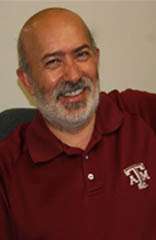Daniele Mortari
| Daniele Mortari | |
|---|---|
 Daniele Mortari | |
| Born |
June 30, 1955 Colleferro (Italy) |
| Alma mater | Universita' degli Studi di Roma "La Sapienza" |
| Known for |
Flower Constellations k-vector The Theory of Connections |
| Awards |
2007 IEEE Judith A. Resnik Award Fellow AAS[1] |
| Scientific career | |
| Doctoral students |
Emilio Morandini († April 26, 2009) Keun-Joo Park Mattew Paul Wilkins Ossama Abdelkhalik Christian Bruccoleri Benjamin Spratling Troy Henderson Reza R. Karimi Brien Flewelling Jonathan Missel Francesco de Dilectis Sanghyun Lee Stoian Borissov |
| Website |
mortari |
Daniele Mortari is Professor of Aerospace Engineering at Texas A&M University and Chief Scientist for Space for Texas A&M ASTRO Center.[2] Mortari is known for inventing the Flower Constellations and the k-vector range searching technique and the Theory of Connections.
Mortari was named Fellow of the Institute of Electrical and Electronics Engineers (IEEE) in 2016[3] "for contributions to navigational aspects of space systems", Fellow of the American Astronautical Society (AAS) in 2012 "for outstanding contributions to astronautics", recipient of 2015 Dirk Brower Award (AAS) "for seminal contributions to the theory and practice of spacecraft orbital and rotational dynamics, particularly attitude determination and satellite constellation design", and of 2007 IEEE Judith A. Resnik Award "for innovative designs of orbiting spacecraft constellations, and efficient algorithms for star identification and spacecraft attitude estimation". His other notable awards include: Texas A&M College of Engineering, Herbert H. Richardson Fellow Award,[4] (2015). Texas A&M College of Engineering, William Keeler Memorial Award,[5] (2015). Best Paper Award,[6] Mechanics Meeting Conference, Honorary Member of IEEE-AESS Space System Technical Panel,[7] (Sep. 2009), NASA Group Achievement Award, (May 2008), AIAA, Associate Fellow, (Nov. 2007), IEEE-AESS Distinguished Speaker,[8] (Feb. 2005), Spacecraft Technology Center Award (Jan. 2003), NASA Group Achievement Award, (May 1989).
Flower constellations
The original theory of Flower Constellations has been proposed in 2004.[9] Then, the theory has evolved, moving to the 2-D Lattice theory,[10] to the 3-D lattice theory,[11] and recently, to the Necklace theory.[12] pdf]) These constellations are particularly suitable for classic applications, such as space-based navigation systems (e.g., GPS and Galileo), Earth observation systems (global, regional, persistent, uniform, weighted), and communication systems. Some more advanced and futuristic applications, such as Hyland's intensity correlation interferometric system, configurations to provide global internet broadband service from space, and solar system communication networks, are currently studied.
k-vector
The k-vector is a range searching technique that can be applied to fast retrieve data from any static database. The k-vector technique was initially proposed to identify stars observed by star trackers on board spacecrafts. Then, it has been applied to solve different kinds of problems belonging to different fields, such as: 1) nonlinear functions inversion and intersection, 2) extensive sampling data generation with assigned analytical (or numerical) distribution, 4) find approximate solutions of nonlinear Diophantine equations, and 4) iso-surface identification for 3-dimensional data distributions and level set analysis.
Theory of Connections
The Theory of Connection is a mathematical procedure to obtain general expressions, y = f(x), called constrained expressions, subject to linear constraints on the function and its derivatives defined at specified values. These expressions can be used describe functions with embedded linear constraints on multiple points. This allows to solve linear differential equations by least-squares as the "subject to:" conditions of differential equations are embedded in the constrained expressions.
References
- ↑ "Fellows | American Astronautical Society". Astronautical.org. Retrieved 2017-05-04.
- ↑ "ASTRO Center – Bringing together the aerospace research being performed at Texas A&M University". Astrocenter.tamu.edu. Retrieved 2017-05-04.
- ↑ "2016 elevated fellow" (PDF). IEEE Fellows Directory.
- ↑ Schnettler, Timothy (2015-05-07). "Banks recognizes Faculty and Staff Award winners | 07 | 05 | 2015 | News & Events | College of Engineering". Engineering.tamu.edu. Retrieved 2017-05-04.
- ↑ "College of Engineering Teaching, Service and Contribution Awards recipients announced | 16 | 02 | 2015 | News & Events | College of Engineering". Engineering.tamu.edu. 2015-02-16. Retrieved 2017-05-04.
- ↑ Elliott, Rebekah (2011-02-25). "Mortari and Spratling win best paper at AAS/AIAA conference | 25 | 02 | 2011 | News & Events | College of Engineering". Engineering.tamu.edu. Retrieved 2017-05-04.
- ↑ "Space Systems | Aerospace & Electronic Systems Society". Ieee-aess.org. Retrieved 2017-05-04.
- ↑ "Distinguished Lecturer and Tutorial Program | Aerospace & Electronic Systems Society". Ieee-aess.org. Retrieved 2017-05-04.
- ↑
- ↑
- ↑
- ↑